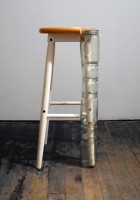NAOKO ITO
Наоко Ито
나오코 이토
Urban Nature – Tangent
source: kulturologiaru
Японцы умеют удивлять – вряд ли кто-то будет спорить с этим утверждением. Взять хотя бы Наоко Ито (Naoko Ito): для своих инсталляций она использует обыкновенные стеклянные банки. Правда, их содержимое довольно необычно для зрителя: вместо аппетитных огурчиков и помидорчиков или сладкого варенья в емкостях «законсервированы»… деревья.
Ветки деревьев и банки для консервации – вещи довольно обыденные и прозаичные. Но сложив эти предметы воедино, Наоко Ито смогла удивить зрителей. Для создания инсталляции автор распиливает ветки на составные части, помещает их в банки различных размеров, а затем составляет из стеклянной тары пирамиду. При этом банки размещаются так, что исходная ветка словно восстанавливается, и возникает ощущение, что дерево растет внутри неустойчивого прозрачного сооружения.
Инсталляции из банок – часть прошлогоднего проекта Наоко Ито «Urban Nature 2009». Что примечательно, есть среди работ Наоко и инсталляция с веткой цветущего вишневого дерева. Вероятно, таким образом автор хотела подчеркнуть свои японские корни.
Наоко Ито родилась в Токио (Япония). Обладает степенью бакалавра Musashino Art University (Токио) и степенью магистра School of Visual Arts (Нью-Йорк). В настоящее время автор живет и работает в Нью-Йорке.
.
.
.
.
.
.
source: co2-art-sustainabilityblogspot
My passion is to create environments that involve working with the various characteristics of materials to convey philosophical insights. Specifically, I investigate questions regarding today’s highly technological world and how we operate in/with it. My background as a graphic designer and as the daughter of an architect father steers my art into more three dimensional, contractual, and design related aspects. Using a wide range of everyday materials such as wood, books and wire to create visual metaphors, I have endeavored to make my work poetic and to blur the boundary between beauty and the grotesque. For example, I utilize glass jars for multiple reasons. One is as a metaphor for preserving food, another to typify mass production and consumer culture, still another has to do with recycling. The use of the glass jar itself involves containing, controlling, even forcing a specific condition. My work suggests unseen layers of industrialism, ideology, and globalization. It intensifies the viewer’s experience of the five senses implicitly and explicitly from a new perspective, and by creating contrasts between simplicity and complexity.
I am documenting contemporary issues/scenes and exploring how to make an environment to observe the delicate relationship between nature and technology in contemporary society, to rearrange conventional thoughts and rules, to question rational categorization, and to approach fresh aesthetics in unconventional ways. I have endeavoured to make poetic environments and to blur the boundary between simplicity and complexity that reflect identity and experiences.
New York has a lot of parks but I feel like the park is fake nature. I started thinking about how, especially in the New York area, in urban areas, how people get along with nature. How they contain it. – Naoko Ito
.
.
.
.
.
.
source: nyllsonoliveirablogspot
Naoko Ito é uma artista japonesa que mora e trabalha atualmente em Nova York. Trabalhando com instalações de arte, Ito explora o conceito de natural versus artificial, da natureza versus o urbano.
Colocando galhos de árvores dentro de potes de vidro transparente, a artista arrumando-os de forma que pareça que as partes dos galhos e ramos ainda se toquem, como se fossem ainda parte de um todo conectado da árvore. Vistas do ângulo correto, as instalações de Naoko Ito fazem com que os galhos se encaixem tão perfeitamente, que parecem mais ser obra de manipulação digital de imagens do que um trabalho real. Ou ainda como se os vidros transparentes estivessem apenas na frente dos galhos, mostrando imagens cortadas, como acontece em grandes telões formadas por várias televisões.


